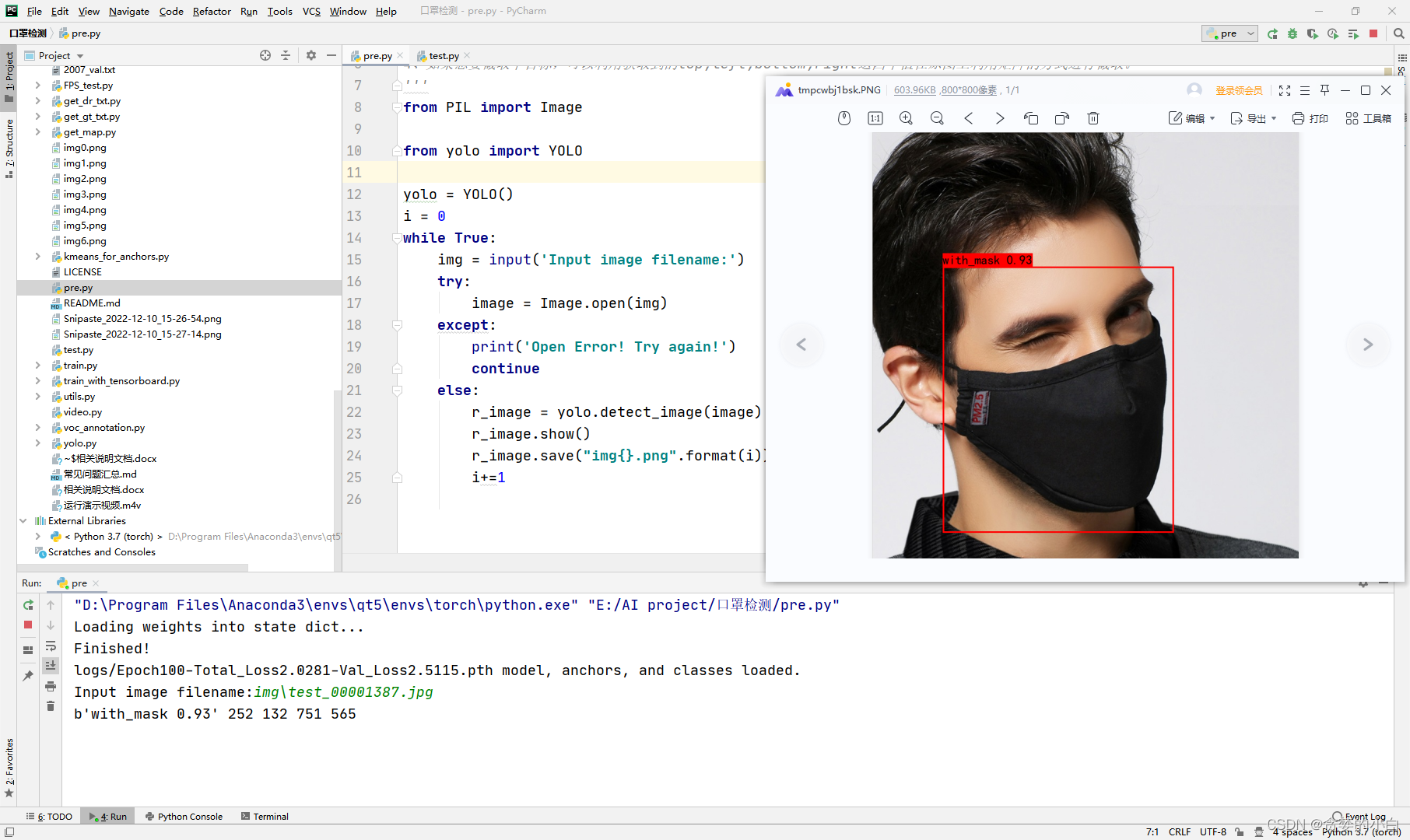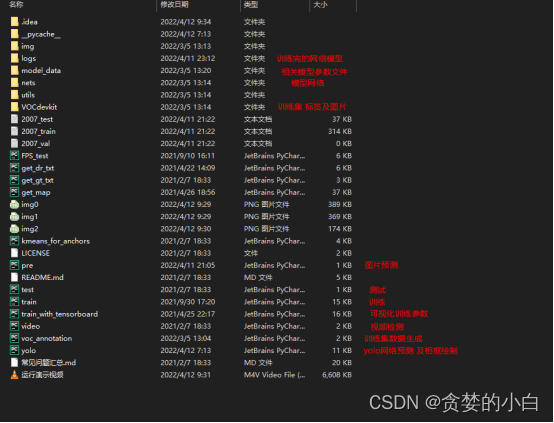yolo口罩佩戴检测(提供全部源代码)
一、项目简介
闲鱼APP搜索“ AI深度学习 "用户,主页中即可查看获取项目。
1)概述:后疫情时代,佩戴口罩已经成为了每个人的习惯。本项目以口罩佩戴为主题,通过深度学习算法,采用yolo目标检测网络对是否佩戴口罩进行检测识别,含图像与实时摄像头两种方式,准确率达98%以上。
2)部分运行效果图:


二、项目结构及环境
提供项目全部源码,在普通电脑CPU/GPU上可以实时检测和识别
整个项目中,主要的文件内容有:

主要环境库:
matplotlib==3.4.2
matplotlib-inline==0.1.2
mistune==0.8.4
nbclient==0.5.3
nbconvert==6.1.0
nbformat==5.1.3
nest-asyncio==1.5.1
notebook==6.4.0
numpy==1.21.0
packaging==21.0
pandocfilters==1.4.3
parso==0.8.2
pickleshare==0.7.5
Pillow==8.3.1
prometheus-client==0.11.0
prompt-toolkit==3.0.19
pycparser==2.20
Pygments==2.9.0
pyparsing==2.4.7
pyrsistent==0.18.0
python-dateutil==2.8.1
pywin32==301
pywinpty==1.1.3
pyzmq==22.1.0
qtconsole==5.1.1
QtPy==1.9.0
Send2Trash==1.7.1
six==1.16.0
terminado==0.10.1
testpath==0.5.0
torch==1.9.0+cu102
torchaudio==0.9.0
torchvision==0.10.0+cu102
tornado==6.1
traitlets==5.0.5
typing-extensions==3.10.0.0
wcwidth==0.2.5
webencodings==0.5.1
widgetsnbextension==3.5.1
zipp==3.5.0
PyQt5==5.12.3
PyQt5-sip==12.9.0
PyQt5-stubs==5.15.2.0
使用anaconda+pycharm的环境工具搭配更加方便,点击获取工具包:
链接:https://pan.baidu.com/s/18rHOYL8lroRwwJygwz0A0w?pwd=wvgw
提取码:wvgw

三、网络结构介绍
yolo.py
import colorsys
import os
import cv2
import numpy as np
import torch
import torch.backends.cudnn as cudnn
import torch.nn as nn
from PIL import Image, ImageDraw, ImageFont
from torch.autograd import Variable
from nets.yolo4_tiny import YoloBody
from utils import (DecodeBox, bbox_iou, letterbox_image,
non_max_suppression, yolo_correct_boxes)
class YOLO(object):
_defaults = {
"model_path" : 'logs/Epoch100-Total_Loss2.0281-Val_Loss2.5115.pth',
"anchors_path" : 'model_data/yolo_anchors.txt',
"classes_path" : 'model_data/mask_classes.txt',
"model_image_size" : (416, 416, 3),
"confidence" : 0.9,
"iou" : 0.1,
"cuda" : False,
#---------------------------------------------------------------------#
# 该变量用于控制是否使用letterbox_image对输入图像进行不失真的resize,
# 在多次测试后,发现关闭letterbox_image直接resize的效果更好
#---------------------------------------------------------------------#
"letterbox_image" : False,
}
@classmethod
def get_defaults(cls, n):
if n in cls._defaults:
return cls._defaults[n]
else:
return "Unrecognized attribute name '" + n + "'"
#---------------------------------------------------#
# 初始化YOLO
#---------------------------------------------------#
def __init__(self, **kwargs):
self.__dict__.update(self._defaults)
self.class_names = self._get_class()
self.anchors = self._get_anchors()
self.generate()
#---------------------------------------------------#
# 获得所有的分类
#---------------------------------------------------#
def _get_class(self):
classes_path = os.path.expanduser(self.classes_path)
with open(classes_path) as f:
class_names = f.readlines()
class_names = [c.strip() for c in class_names]
return class_names
#---------------------------------------------------#
# 获得所有的先验框
#---------------------------------------------------#
def _get_anchors(self):
anchors_path = os.path.expanduser(self.anchors_path)
with open(anchors_path) as f:
anchors = f.readline()
anchors = [float(x) for x in anchors.split(',')]
return np.array(anchors).reshape([-1, 3, 2])
#---------------------------------------------------#
# 生成模型
#---------------------------------------------------#
def generate(self):
#---------------------------------------------------#
# 建立yolov4_tiny模型
#---------------------------------------------------#
self.net = YoloBody(len(self.anchors[0]), len(self.class_names)).eval()
#---------------------------------------------------#
# 载入yolov4_tiny模型的权重
#---------------------------------------------------#
print('Loading weights into state dict...')
device = torch.device('cuda' if torch.cuda.is_available() else 'cpu')
state_dict = torch.load(self.model_path, map_location=device)
self.net.load_state_dict(state_dict)
print('Finished!')
if self.cuda:
os.environ["CUDA_VISIBLE_DEVICES"] = '0'
self.net = nn.DataParallel(self.net)
self.net = self.net.cuda()
#---------------------------------------------------#
# 建立特征层解码用的工具
#---------------------------------------------------#
self.yolo_decodes = []
self.anchors_mask = [[3,4,5],[1,2,3]]
for i in range(2):
self.yolo_decodes.append(DecodeBox(np.reshape(self.anchors,[-1,2])[self.anchors_mask[i]], len(self.class_names), (self.model_image_size[1], self.model_image_size[0])))
print('{} model, anchors, and classes loaded.'.format(self.model_path))
# 画框设置不同的颜色
hsv_tuples = [(x / len(self.class_names), 1., 1.)
for x in range(len(self.class_names))]
self.colors = list(map(lambda x: colorsys.hsv_to_rgb(*x), hsv_tuples))
self.colors = list(
map(lambda x: (int(x[0] * 255), int(x[1] * 255), int(x[2] * 255)),
self.colors))
#---------------------------------------------------#
# 检测图片
#---------------------------------------------------#
def detect_image(self, image):
image_shape = np.array(np.shape(image)[0:2])
#---------------------------------------------------------#
# 给图像增加灰条,实现不失真的resize
# 也可以直接resize进行识别
#---------------------------------------------------------#
if self.letterbox_image:
crop_img = np.array(letterbox_image(image, (self.model_image_size[1],self.model_image_size[0])))
else:
crop_img = image.convert('RGB')
crop_img = crop_img.resize((self.model_image_size[1],self.model_image_size[0]), Image.BICUBIC)
photo = np.array(crop_img,dtype = np.float32) / 255.0
photo = np.transpose(photo, (2, 0, 1))
#---------------------------------------------------------#
# 添加上batch_size维度
#---------------------------------------------------------#
images = [photo]
with torch.no_grad():
images = torch.from_numpy(np.asarray(images))
if self.cuda:
images = images.cuda()
#---------------------------------------------------------#
# 将图像输入网络当中进行预测!
#---------------------------------------------------------#
outputs = self.net(images)
output_list = []
for i in range(2):
output_list.append(self.yolo_decodes[i](outputs[i]))
#---------------------------------------------------------#
# 将预测框进行堆叠,然后进行非极大抑制
#---------------------------------------------------------#
output = torch.cat(output_list, 1)
batch_detections = non_max_suppression(output, len(self.class_names),
conf_thres=self.confidence,
nms_thres=self.iou)
#---------------------------------------------------------#
# 如果没有检测出物体,返回原图
#---------------------------------------------------------#
try:
batch_detections = batch_detections[0].cpu().numpy()
except:
return image
#---------------------------------------------------------#
# 对预测框进行得分筛选
#---------------------------------------------------------#
top_index = batch_detections[:,4] * batch_detections[:,5] > self.confidence
top_conf = batch_detections[top_index,4]*batch_detections[top_index,5]
top_label = np.array(batch_detections[top_index,-1],np.int32)
top_bboxes = np.array(batch_detections[top_index,:4])
top_xmin, top_ymin, top_xmax, top_ymax = np.expand_dims(top_bboxes[:,0],-1),np.expand_dims(top_bboxes[:,1],-1),np.expand_dims(top_bboxes[:,2],-1),np.expand_dims(top_bboxes[:,3],-1)
#-----------------------------------------------------------------#
# 在图像传入网络预测前会进行letterbox_image给图像周围添加灰条
# 因此生成的top_bboxes是相对于有灰条的图像的
# 我们需要对其进行修改,去除灰条的部分。
#-----------------------------------------------------------------#
if self.letterbox_image:
boxes = yolo_correct_boxes(top_ymin,top_xmin,top_ymax,top_xmax,np.array([self.model_image_size[0],self.model_image_size[1]]),image_shape)
else:
top_xmin = top_xmin / self.model_image_size[1] * image_shape[1]
top_ymin = top_ymin / self.model_image_size[0] * image_shape[0]
top_xmax = top_xmax / self.model_image_size[1] * image_shape[1]
top_ymax = top_ymax / self.model_image_size[0] * image_shape[0]
boxes = np.concatenate([top_ymin,top_xmin,top_ymax,top_xmax], axis=-1)
font = ImageFont.truetype(font='model_data/simhei.ttf',size=np.floor(3e-2 * np.shape(image)[1] + 0.5).astype('int32'))
thickness = max((np.shape(image)[0] + np.shape(image)[1]) // self.model_image_size[0], 1)
for i, c in enumerate(top_label):
predicted_class = self.class_names[c]
score = top_conf[i]
top, left, bottom, right = boxes[i]
top = top - 5
left = left - 5
bottom = bottom + 5
right = right + 5
top = max(0, np.floor(top + 0.5).astype('int32'))
left = max(0, np.floor(left + 0.5).astype('int32'))
bottom = min(np.shape(image)[0], np.floor(bottom + 0.5).astype('int32'))
right = min(np.shape(image)[1], np.floor(right + 0.5).astype('int32'))
# 画框框
label = '{} {:.2f}'.format(predicted_class, score)
draw = ImageDraw.Draw(image)
label_size = draw.textsize(label, font)
label = label.encode('utf-8')
print(label, top, left, bottom, right)
if top - label_size[1] >= 0:
text_origin = np.array([left, top - label_size[1]])
else:
text_origin = np.array([left, top + 1])
for i in range(thickness):
draw.rectangle(
[left + i, top + i, right - i, bottom - i],
outline=self.colors[self.class_names.index(predicted_class)])
draw.rectangle(
[tuple(text_origin), tuple(text_origin + label_size)],
fill=self.colors[self.class_names.index(predicted_class)])
draw.text(text_origin, str(label,'UTF-8'), fill=(0, 0, 0), font=font)
del draw
return image
五、使用介绍
直接运行pre.py,输入图片地址即可
from PIL import Image
from yolo import YOLO
yolo = YOLO()
i = 0
while True:
img = input('Input image filename:')
try:
image = Image.open(img)
except:
print('Open Error! Try again!')
continue
else:
r_image = yolo.detect_image(image)
r_image.show()
r_image.save("img{}.png".format(i))
i+=1

六、源代码获取
闲鱼APP搜索“ AI深度学习 "用户,主页中即可查看获取。
其他问题可留言,相互交流进步!




















 1819
1819











 被折叠的 条评论
为什么被折叠?
被折叠的 条评论
为什么被折叠?








